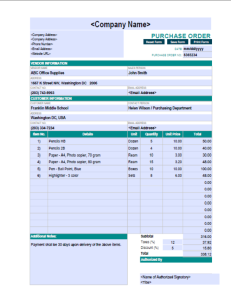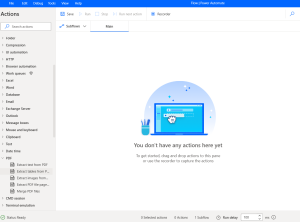Secrets for Successful Android App Development in 2025
Why Salesforce and ERP Integration Fuels Business Growth
Power BI and Excel: How to Leverage Both for Data Reporting
Tips to Find the Right App Development Partner: Key Considerations
Achieving Efficiency in Process Automation
Automation is the process of using technology, such as software, machinery, and other systems, to perform tasks and processes with minimal or no human intervention. Its primary goals are to increase efficiency, improve accuracy, reduce costs, and free up human resources for more complex and creative tasks. Automation is widely used in various industries, including manufacturing, IT, finance, and service sectors.
What is Process Automation?
Process automation is the use of technology to execute recurring tasks or processes in a business where manual effort can be replaced. It aims to streamline workflows, reduce the need for human intervention, improve efficiency, and ensure consistency in operations. By automating processes, organizations can save time, reduce errors, and increase productivity. Common tools for process automation include software applications, robotic process automation (RPA), and artificial intelligence (AI) systems.
Key reasons why Process Automation fails.
- Lack of Clear Objectives: Without well-defined goals and expectations, it’s difficult to measure success or ensure the project meets business needs.
- Inadequate Planning and Preparation: Failing to thoroughly plan and prepare for automation can lead to missed requirements, unrealistic timelines, and resource shortages.
- Insufficient Stakeholder Engagement: If key stakeholders, including end-users, are not involved in the project, the solution may not meet their needs or gain necessary support.
- Poor Change Management: Automation often requires changes in workflows and job roles. If these changes are not well-managed, employees may resist or not adapt well to the new system.
- Lack of Expertise: Without the right technical skills and experience, the automation solution may be poorly designed or implemented, leading to technical issues and inefficiencies.
- Overlooking Process Analysis: Automating a poorly designed process will not yield the desired benefits. It’s crucial to optimize the process before automating it.
- Insufficient Testing and Maintenance: Failing to thoroughly test the automated processes can result in errors and disruptions. Continuous maintenance is also necessary to address any issues and make improvements.
- Ignoring Data Quality: Automation relies on accurate and consistent data. Poor data quality can lead to errors and inefficiencies in automated processes.
- Lack of Scalability: An automation solution that cannot scale with the business can quickly become obsolete or require costly rework.
How to overcome challenges in Process Automation?
- Define Clear Objectives and Scope
- Set Specific Goals: Clearly outline what the automation project aims to achieve, such as reducing costs, improving accuracy, or increasing speed. These goals should be measurable and aligned with overall business objectives.
- Scope Management: Define the boundaries of the project to prevent scope creep. Identify which processes are to be automated and establish criteria for success.
- Thorough Planning and Preparation
- Detailed Roadmap: Develop a comprehensive project plan that includes timelines, milestones, resource allocation, and risk management strategies.
- Resource Assessment: Ensure that you have the necessary resources, including skilled personnel, technology, and budget, before starting the project.
- Engage Stakeholders Early and Often
- Inclusive Involvement: Involve all relevant stakeholders, including management, IT, and end-users, from the outset. Their input can provide valuable insights and help in gaining buy-in.
- Regular Communication: Maintain open lines of communication throughout the project to keep stakeholders informed and engaged.
- Effective Change Management
- Change Management Plan: Develop a plan to manage the changes automation will bring. This should include strategies for training, communication, and support to help employees adapt.
- Training Programs: Provide comprehensive training to ensure that users understand how to work with the new automated processes.
- Build Expertise and Leverage External Knowledge
- Skilled Team: Assemble a team with the necessary technical and process expertise. This might include hiring new talent or upskilling existing employees.
- Consult External Experts: When necessary, seek advice from consultants or experts in process automation to guide the project.
- Optimize Processes before Automating
- Process Analysis: Conduct a thorough analysis of the processes you plan to automate. Identify inefficiencies and areas for improvement.
- Process Redesign: Redesign processes to optimize performance before implementing automation. This ensures that you are not automating inefficiencies.
- Comprehensive Testing and Continuous Maintenance
- Rigorous Testing: Perform extensive testing of the automated processes in a controlled environment before full deployment. This helps identify and fix issues early.
- Ongoing Maintenance: Establish a maintenance plan to regularly review and update the automated systems. This ensures they continue to function correctly and adapt to any changes in the business environment.
- Accurate Cost Estimation and Budgeting
- Detailed Budgeting: Create a detailed budget that accounts for all potential costs, including initial implementation, training, maintenance, and potential contingencies.
- Monitor Expenses: Regularly track and review expenses to ensure the project stays within budget.
- Ensure Data Quality and Integration
- Data Cleaning: Ensure that the data used in the automation process is accurate, complete, and consistent. Clean and standardize data before implementation.
- Seamless Integration: Ensure that the automation tools integrate smoothly with existing systems and data sources. This prevents data silos and ensures seamless operation.
- Design for Scalability and Flexibility
- Scalable Solutions: Choose automation tools and technologies that can scale with your business. This ensures that the solution can grow and adapt as your needs change.
- Flexible Architecture: Design the system to be flexible and adaptable, allowing for easy modifications and updates as new requirements arise.
Let’s have a look at Recent Trends in Process Automation:
- AI and Machine Learning Integration: AI and machine learning are being increasingly integrated into process automation to enhance decision-making, predict outcomes, and improve efficiency. This includes predictive maintenance, anomaly detection, and intelligent process automation (IPA).
- Robotic Process Automation (RPA): RPA continues to be a major trend, with more sophisticated bots that can handle complex tasks and integrate with various systems. The focus is on scaling RPA across the enterprise and integrating it with other technologies like AI and machine learning.
- Intelligent Document Processing (IDP): IDP uses AI to automate the processing of unstructured data from documents, emails, and other sources. This helps in streamlining data entry and improving accuracy.
- Hyper automation: This involves the use of multiple technologies such as RPA, AI, machine learning, and analytics to automate as many business processes as possible. Hyper automation aims to create a more comprehensive and efficient automation strategy.
- Low-Code/No-Code Platforms: These platforms allow business users to create automation workflows without extensive programming knowledge. This democratizes process automation and accelerates digital transformation initiatives.
- Process Mining and Discovery: Process mining tools help organizations understand and analyze their existing processes to identify automation opportunities. These tools provide insights into process inefficiencies and bottlenecks.
- Cloud-Based Automation Solutions: Cloud-based automation solutions offer scalability, flexibility, and reduced infrastructure costs. They also enable remote work and collaboration, which is increasingly important in today’s business environment.
Conclusion:
While the path to process automation might be difficult, knowing and overcoming these barriers helps pave the road for effective adoption.
Businesses can address these challenges by prioritizing change management, phased deployment, seamless integration, skill development, data security, process definition, and transparent measurement.
Embracing these solutions not only ensures a smoother transition but also positions organizations for long-term success in an increasingly automated world.
Measuring Key metrics for BI implementation success
Ensuring Compliance in Today’s Data-Driven Era
We live in an era where digitalization shapes all our interactions, transactions, and work. Digital Transformation is no longer a buzzword – it is a necessity for businesses to integrate digital technologies in all aspects of their operations to survive and thrive.
However, most industries need to comply with the laws and regulations applicable to ensure the trust and security of their stakeholders and customers. While digital transformation can drive innovation and give a competitive edge, failure to consider its impact on regulations can result in penalties, lawsuits, and loss of reputation.
Ensuring regulatory compliance is an integral part of your digital transformation strategy. It can help your business avoid pitfalls and give you a competitive edge in the industry.
In this blog, we will explore how businesses can reap the benefits of ensuring compliance in the age of digital transformation.
Regulatory Compliance in highly regulated industries
While every industry operates on some form of rules, laws and regulations, some sectors have more stringent regulatory laws than others. Industries like Pharmaceutical and Healthcare, Finance & Banking, Education, and the legal sector (to name a few) have a heavier impact of laws and regulations in their functioning.
The reason is that these industries generate and use sensitive and confidential data -like personal, medical, financial information, and trade secrets. Recently, there has been a shift in these industries towards digital technologies to collect, analyze, and store data from various sources – whether it is cloud services, IoT implementation, or using BI (Business Intelligence) software for data analytics.
This technological shift in operations makes enterprises vulnerable to security breaches and data leaks, and it is critical to safeguard this data to protect public interests.
The regulatory authorities monitoring this compliance ensure that organizations handle data with ethical fairness and transparency in all functions, including while implementing digital transformation initiatives.
For example, the healthcare industry uses confidential patient data for research, drug development and patient outcomes. While they have adopted digitalization in the form of EHRs (Electronic Health Records) and telemedicine, they must also comply with the GDPR (General Data Protection Regulation) in Europe and HIPAA (Health Insurance Portability and Accountability Act) in the US.
Similarly, the Finance industry is rapidly evolving and adopting advanced technologies like Blockchain, Artificial Intelligence, and advanced data analytics and BI (Business Intelligence) tools. In doing so, they must consider the impact of technologies adopted on compliance with GDPR and the Sarbanes-Oxley Act.
How can companies Ensure compliance while adopting data-driven processes?
Industries can successfully implement data-driven initiatives and technologies while navigating regulations and compliance in the following ways:
Reviewing existing compliance programs
Implementing an ISMS (Information Security and Management System) like ISO and other external audits
Setting up Data Policies and Procedures
Implementing measures for data protection and security
Conducting Regular Internal audits for data protection
Balancing Innovation with Compliance in the Age of Digital Transformation
While innovation is the catalyst for industries to drive growth, compliance is the backbone of highly regulated industries that keeps them from falling apart. It is crucial to balance the innovation brought about by implementing digital transformation with the necessity of regulations.
To maintain this delicate balance, innovation and compliance must be netted into the organization’s culture.
Your digital transformation strategies should include selecting technologies that align with the business’s operational goals and objectives. On the other hand, enterprises should adopt a compliance-first culture to ensure that none of the technologies employed to collect, analyze, and store data overlooks the data protection and regulatory guidelines. Whether an MSE or an international enterprise with varying local laws and rules, industries can adapt their digital strategies coordinated with the regulations respective to their operating regions.
Conclusion
As a final note, while implementing digital transformation initiatives – whether developed in-house or by hiring a technology service provider in – let’s say, Cloud, IoT, or BI services, ensuring compliance with the regulations is tricky but crucial for businesses. By ensuring compliance with data protection laws, companies can avoid unnecessary penalties and losses and maintain trust and goodwill among their stakeholders and customers.
Additionally, the digital transformation strategy must involve a fine balance between technological innovations and following rules and laws to tread the path of growth with a competitive edge in the digital era and beyond.
At Codeplateau, we consider data protection and privacy in high regard while ensuring our customers can harness the full benefits of our digital transformation services.
If you have any questions or would like to know more about our services, feel free to contact us– we are always happy to help!
Carbon credits for industries: A comprehensive overview
As the effects of climate change are becoming undeniably visible with time, there is an increasing awareness of terms like carbon, credit, carbon footprint, or carbon offsets.
In this blog, we will explore what carbon credits for industries mean and their solutions to reduce carbon footprint in detail.
International efforts to reduce carbon footprint
The United Nations (UN) set up the IPCC (Intergovernmental Panel on Climate Change) to address the challenges of climate change. To mitigate climate change effects, the panel set goals to reduce carbon pollution so that the temperature increase stabilizes to 1.5 degrees by 2100 compared to pre-industrial levels.
The increasing temperature of the earth is due to the total amount of carbon present in the atmosphere, not just the carbon emitted.
Therefore, to completely halt the temperature increase, we must balance the carbon emitted with removing carbon from the atmosphere.
In particular, for each gram of carbon that businesses and individuals emit, they must extract one gram of carbon from the atmosphere.
Consequently, this will ensure the overall mass of carbon in the atmosphere remains fixed and that there is a net-zero emission.
To achieve this target, we need to reduce our overall emissions to a 45% reduction by 2030 and reach a net-zero target by 2050.
Assigning carbon credits was a mechanism devised by the Kyoto Protocol in 1997 and the Paris Agreement in 2015 formed by the IPCC to quantify the carbon footprints of an industry.
Background – Carbon Credits, Carbon Offsets and Carbon Markets
All industrial activities inevitably produce carbon and other Greenhouse gases (GHGs) as a biproduct. The government permits industries to emit a limited amount of these GHGs or carbon to curb its adverse climatic impact.
Carbon credits:
A ton of GHG gases emitted equals one carbon credit. For a company, the number of credits received declines over time, and they can sell any surplus credits to other companies to reduce their carbon footprint.
Carbon Offsets:
Similarly, when a company removes carbon emissions as a part of its business activity, it generates an offset. The companies can offset their excess emissions by using renewable energy sources or energy-efficient processes, planting more trees, etc. Other companies can then purchase this carbon offset to reduce their carbon footprint.
Carbon markets:
On that account, the voluntary and regulated carbon markets had materialized. Carbon markets facilitate the companies to trade (buy or sell) their carbon credits and offsets.
In a regulated carbon market, governments or authorities issue carbon credits as a part of regulatory compliance, and the trading works on “cap-and-trade-model”.
On the other hand, voluntary carbon markets allow businesses and individuals to trade carbon credits to offset carbon emissions. However, unlike regulated markets, it is not mandated.
How are carbon credits for industries generated?
With today’s climate crisis, Sustainability and Corporate Social Responsibility are increasingly becoming the integral pillars of industries’ functioning. Various industries – including manufacturing, plastics, automotive, pharmaceuticals, Finance industry, aviation, and logistics are major carbon emitters and are therefore required to mitigate their carbon footprint and make net-zero commitments.
In practice, for most industries, the efforts in this direction involve setting up heavy treatment plants and implementing advanced technologies and other cash-heavy solutions.
However, there are some projects that industries can implement to generate carbon credits:
Invest in renewable energy –
by using renewable energy sources like solar, wind, geothermal, etc, for business activities or funding projects to generate renewable energy by using such sources.
Capture carbon from the atmosphere –
There are specific devices that companies can use to extract carbon from the atmosphere and store it on earth, which can then be used by plants or as a biofuel.
Recycling of materials like plastics
Soil carbon sequestration for agriculture –
farmers can extract soil from the atmosphere and store it in the soil that they can use for farming and productive activities.
Planting more trees and afforestation
Develop Energy-efficient products and services
that use less energy and produce more output.
Use substitute fuel sources-
like biofuels, bio-derived ethanol etc, for production activities.
Overall, increasing education and developing practical solutions to reduce carbon footprint are vital for industries to encourage green operations.
How do companies measure their carbon credits?
Predominantly, most companies aim to offset carbon emissions and position themselves as green companies with sustainable practices. But how do they measure the amount of carbon emissions reduced? How do they ensure the carbon credits they buy from other companies are authentic?
MRV (Monitoring, Reporting and Validation) of carbon credits
MRV (Measurement, Reporting and Validation) is a multi-step process through which third-party authorities can evaluate the carbon offset data.
Measurement:
It is the degree to which the evaluating party can quantify the carbon removal efforts of a company. Organizations must define a process or technology to measure the carbon removal from a specific project or activity. Then, they conduct measurements infield and update and revise protocols as and when required.
Reporting:
It includes providing reliable data and information related to measurement in a transparent and usable format. The developers of carbon removal projects set up a process for gathering, saving and presenting the data. They can either report this data to the evaluating parties or make the information on carbon credits publicly available.
Verification:
Independent third parties access and verify whether the data for carbon removal is accurate and complete. For this purpose, they conduct an audit at the beginning of a carbon removal project to validate it. Further, they monitor the emission reductions on an ongoing basis.
MRV is a mainstay mechanism for carbon markets that builds accountability and trust in the carbon-reduction
ecosystem. Hence, the accuracy and validity of data are crucial in maintaining the integrity of this system.
Digital technologies to reduce carbon credit:
To achieve long-term success in reducing carbon footprint and generating carbon credits, companies must invest in digital technologies that significantly reduce the use of paper and other carbon-generating activities.
Various studies have supported digitization in the operational process to yield sustainable outcomes for industries. For example, organizations can go paperless and increase efficiency by adopting digital data reporting and analytics systems like Microsoft Power BI instead of paper-based reporting systems.
Not only internal operations, but industries can also implement digital technologies to measure their sustainability initiatives and track progress towards their net-zero goals.
Further, technological advancements in digitizing and tokenizing carbon credits can streamline the carbon-trading process with increased transparency and accuracy.
Several countries are now implementing Digitization of MRV (DMRV) systems that simplify the MRV process and increase the efficiency of carbon markets.
Conclusion
As a part of international efforts to counter the impact of climate change, the IPCC devised climate credits as a mechanism for reducing carbon emissions from businesses and individuals. It creates a regulated and voluntary market where companies can trade carbon credits or permits for emissions.
Various industries with high carbon emissions can generate carbon credits and offsets by adopting sustainable practices for their operations.
The companies that cannot do so need to buy carbon credits from other companies and operate at a higher cost.
Moreover, independent third-party authorities access the validity and authenticity of the carbon credits of a company through a Monitoring, reporting, and evaluating system. This system creates trust and accountability amongst industries while trading carbon credits or offsets.
Finally, by embracing digital technologies, industries can reduce their carbon footprint and increase their carbon credit, thus contributing to a greener earth.
If you are wondering how digital technologies can enable growth in your organization without compromising on its environmental impact, you’ve come to the right place. Share your questions or get in touch with us- and let’s see how we can help your business achieve operational efficiency with sustainable digital solutions.












